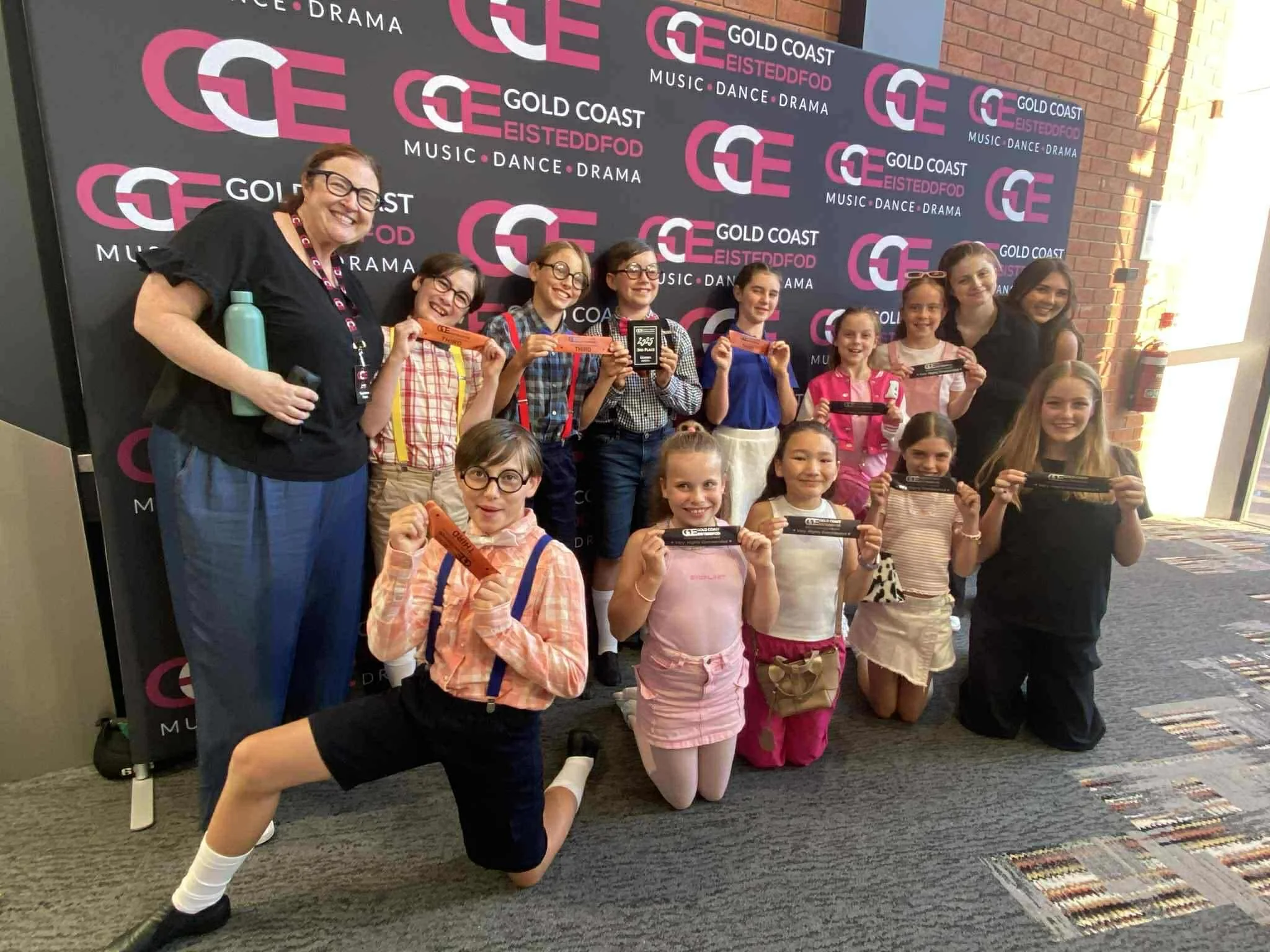NAPA News - Week 5, Term 3, 2025
FROM THE DIRECTOR
Welcome back to Week 5 of Term 3! We have an exciting weekend ahead as our Gold Coast Eisteddfod groups take to the stage for the very first time this year. Our choral group will kick things off on Friday, followed by our junior dance groups on Saturday and Sunday. This is all about celebrating the journey - setting goals, sharing special moments with your teammates, and enjoying the magic of performing together. A huge thank you to our incredible teachers, whose talent, passion, and countless hours of preparation make these opportunities possible for our cherubs.
QUICK REMINDERS
LOST AND FOUND IS FILLING UP AGAIN - PLEASE CHECK
COLD AND FLU SEASON IS STILL HERE - STAY WARM BEFORE AND AFTER CLASSES
DON’T FORGET TO LOG ABSENCES IN YOUR PARENT PORTAL
NEWS HIGHLIGHTS
PERFORMANCE TEAM TICKETS SELLING FAST
Tickets for our Performance Team Concert are now on sale and selling quick! Get in now if you haven’t already purchased your tickets.
The evening will feature our Performance Teams, alongside some of our solo performers. It’s always a super fun night, so come on down and support the dancers!
CONGRATULATIONS SOLOISTS—Gold coast eisteddfod updates
Drama students - it won’t be long until it’s your turn! Make sure you have read all correspondence from your teachers regarding upcoming drama performances at GCE. Check in with your teacher if you need guidance.
ballet exams
Ballet students who are entering exams - your entries have been made and your fee has been added to your portal. Miss Tahnee will keep you updated on all things ballet as the exams approach, so please reach out to her if you have any questions or queries.
Miss Tahnee is offering extra private lessons as exams approach, so be sure to book in if your cherub is interested.
Wellbeing
Gratitude in Motion
When you think of a warm-up, you probably picture stretches, cardio bursts, and maybe a few vocal or breathing exercises. These are all essential—but there’s one warm-up many performers forget: warming up your mindset. At NAPA, we believe a strong mental state is just as vital as strong muscles. The way you step into rehearsal or onto the stage has everything to do with the energy you carry. That’s why we encourage a simple but powerful practice we call Gratitude in Motion.
What It Is
During your warm-up, choose one thing you’re truly grateful for. It doesn’t have to be profound—it could be as big as having the chance to perform at all, or as small as enjoying the smell of fresh rosin on the studio floor. It might be the supportive smile from a friend, the way your body feels strong today, or the sound of the music you get to dance to.
Why It Works
Gratitude changes your body chemistry. Research shows that focusing on what you’re thankful for increases dopamine and serotonin—the feel-good brain chemicals. It also quiets the stress response, which means you perform with more freedom and less tension. You simply can’t feel deeply stressed and deeply grateful at the same time—your brain won’t allow it.
When you channel gratitude into your movement, your steps feel lighter, your energy brighter, and your presence more open. The audience feels that difference—even if they can’t explain why.
How to Do It
Pick Your “One Thing” – As you begin warm-up, take a breath and name one thing you appreciate in that moment.
Breathe It In – On your inhale, think about your gratitude in detail—what it looks, sounds, or feels like.
Move It Through – On your exhale, imagine that feeling spreading through your body and out into your movements. Let it shape your posture, your expression, even the way you place your hands or feet.
Carry It Forward – Hold that awareness as you transition from warm-up into rehearsal or performance.
In Real Life
Picture a dancer backstage before a competition, nerves running high. She takes a moment in her warm-up to think about the fact that her grandmother is in the audience for the first time. She lets that thought fill her chest as she stretches. Suddenly, the tightness in her shoulders softens. Her movements feel more fluid. By the time she steps on stage, her focus is no longer on What if I mess up? but on How lucky I am to share this with her.
That shift—small but powerful—changes everything.
Remember: Gratitude doesn’t just make you feel better—it makes you perform better. When your heart is full, your movement speaks louder, your expression feels authentic, and your performance connects more deeply with your audience.
So next time you warm up, don’t just prepare your body—prepare your mindset. Because gratitude is more than a feeling. On stage, it becomes joy in motion.
CHERUB OF THE WEEK
CONGRATULATIONS LUCAS BROWN!
This week we’re celebrating Lucas, a valued NAPA student since 2020.
Lucas embodies everything we look for in a NAPA cherub—he is hardworking, kind, respectful, and a wonderful teammate. Always ready to lend a helping hand and never without his trademark smile, Lucas brings positivity and dedication to every class. His teachers all have nothing but praise for his attitude and commitment. Lucas, you are a shining example of the NAPA spirit, and we are so proud to have you in our community!
PERFORMANCE TIPS
STORYTELLING THROUGH DANCE
At NAPA, we believe dance is far more than a sequence of steps and polished technique—it’s a living, breathing art form that tells a story without a single spoken word. When a dancer layers character, intention, and emotion over their technique, movement transforms into something magnetic. It’s the kind of performance that lingers in the audience’s mind and heart long after the curtain has closed. This, after all, is what performance and art are truly about—connection, transformation, and shared human experience.
Character First – Before your first run of choreography, pause and ask yourself: Who am I in this piece? Write down three words that define your character’s personality. Are they fierce, playful, fragile, determined, or something entirely different? Let these words colour your movements like a filter over the lens of a camera—affecting everything from the tilt of your chin to the softness or strength in your hands. Two dancers can perform identical choreography, but the moment their characters shift, the performance changes entirely. Rehearse with these traits so deeply that they become instinctive, even under the pressure of stage lights and an audience’s gaze.
Invisible Script – Every movement can be more than a shape—it can be a line of dialogue in an unspoken conversation. Picture what your character would say right before a jump: are they leaping out of joy, rage, or desperation? Imagine what they’re thinking in the stillness after a turn—are they catching their breath, gathering courage, or hiding something? By assigning this “invisible script” to your choreography, you breathe emotional subtext into your performance. The audience might never know the exact words, but they’ll feel their presence, as if the steps themselves are speaking.
Emotional Markers – Every story has moments of impact, and so should your routine. Choose specific points where you want your audience to feel a clear emotion—tension before a big reveal, elation in a burst of movement, grief in a slow fall to the floor. Then magnify these moments physically and energetically. Hold a breath a second longer than expected, drop your focus to the floor in sudden defeat, or let a smile bloom at just the right beat of the music. These emotional markers are like highlights in a novel—they guide your audience’s attention and help them travel through the arc of your story with you.













